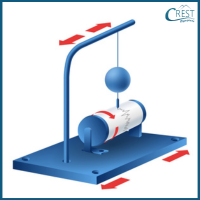1. Which of the following is an example of a natural calamity caused by extreme weather conditions?
a) Tsunami
b) Earthquake
c) Drought
d) Volcanic eruption
Answer: c) Drought is a natural calamity caused by extreme weather conditions, specifically long periods of low rainfall and water scarcity.
2. Kevin had originally planned to go to the beach, but he changed his mind after receiving a warning from the news about a possible natural calamity. Which natural calamity could be the reason for Kevin's change of plans?
a) Tsunami
b) Earthquake
c) Volcanic eruption
d) Drought
Answer: a) Kevin changed his plans to go to the beach after receiving a warning from the news about a possible natural calamity. Since tsunamis are known to occur in coastal areas and can be very dangerous, it would be wise for Kevin to avoid going to the beach in such a situation.
3. What is the purpose of the device shown in the picture?

a) Measuring earthquake intensity
b) Determining cyclone speed
c) Monitoring flood levels
d) Measuring temperature fluctuations
Answer: a) The device shown in the picture is a Richter Scale, which is used to measure the intensity or magnitude of an earthquake. It helps scientists and researchers understand the strength and impact of earthquakes.
4. Match the following types of natural calamities with their respective causes.
| Column I |
Column II |
| 1. Floods |
A) Circulation of powerful winds around low atmospheric pressure |
| 2. Cyclones |
B) Underwater earthquakes or volcanic eruptions |
| 3. Tsunamis |
C) Uncontrolled fires in wooded areas |
| 4. Forest Fires |
D) Heavy rainfall and melting snow |
a) 1:A, 2:D, 3:C, 4:B
b) 1:A, 2:B, 3:D, 4:C
c) 1:B, 2:A, 3:D, 4:C
d) 1:D, 2:A, 3:B, 4:C
Answer: d) Floods: Heavy rainfall and melting snow
Cyclones: Circulation of powerful winds around low atmospheric pressure
Tsunamis: Underwater earthquakes or volcanic eruptions
Forest Fires: Uncontrolled fires in wooded areas
5. What precautionary measures should one take during an earthquake while inside a building?
a) Run outside in the open
b) Take shelter under heavy furniture or tables
c) Enter another building
d) Stay on the upper floors
Answer: b) During an earthquake while inside a building, it is important to find a safe place away from windows, glass, and heavy objects that could fall. Taking shelter under a sturdy piece of furniture, such as a table, can provide protection from falling debris and help safeguard your head and body from potential injuries.


